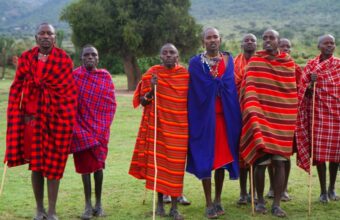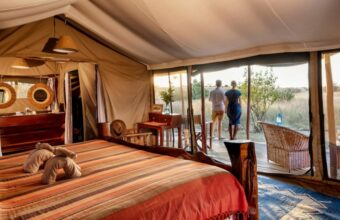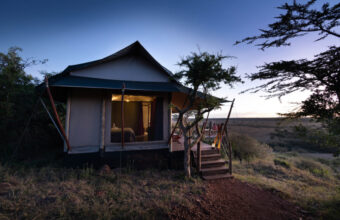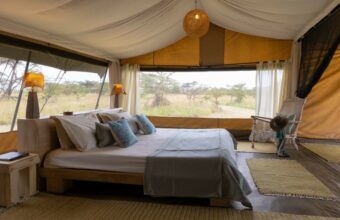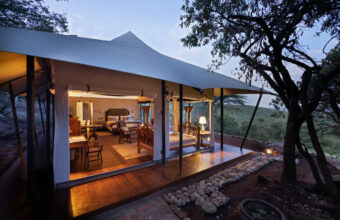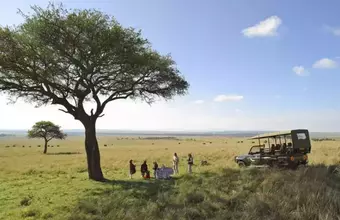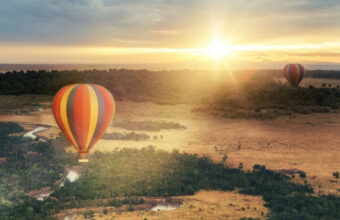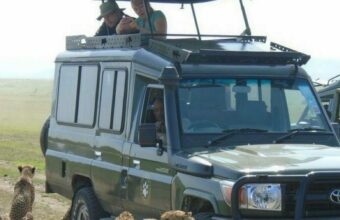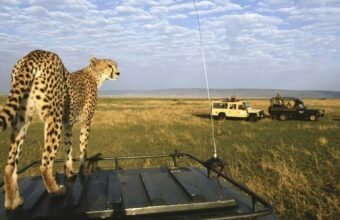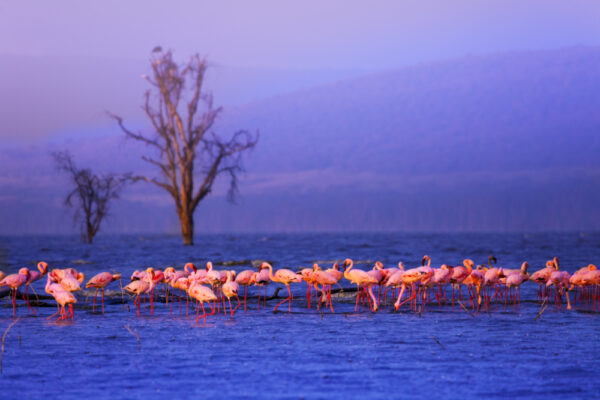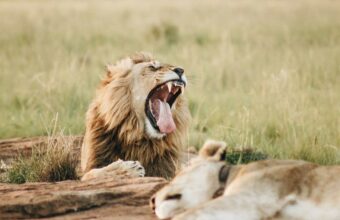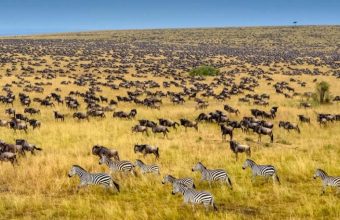Masai Mara safaris
Best safari camps and lodges in the Masai Mara
The very essence of a Kenyan safari landscape, the Masai Mara stretches along the Kenya-Tanzania border and forms the northern fringe of the greater Serengeti ecosystem (most of which is in Tanzania).
The Masai Mara is the part of Kenya in which I have spent the most time (months and months if I added it all up), and was the scene of one of my best ever travel experiences. Some years ago a Maasai friend and I set out on a five week hike that took us across the entire Mara ecosystem. By day we walked alongside the wildlife and Maasai herders. By night we camped out under the stars and slept in traditional Maasai villages. An unforgettable adventure!
Ready to experience it yourself? Here's my essential guide to the best safaris in the Masai Mara.
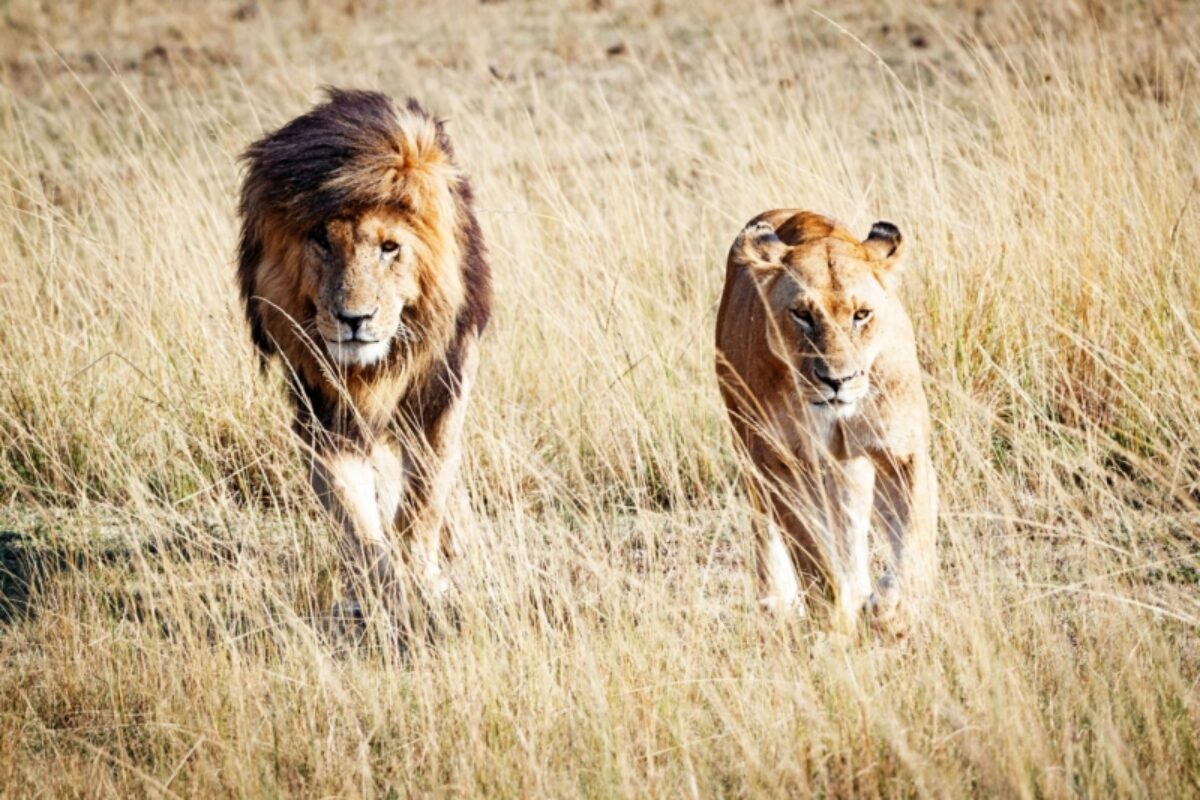
Lions prowling in the Masai Mara
The best Masai Mara safari camps & lodges
Our expert's top picks
-
Masai Mara National Reserve
-
Mara North Conservancy
-
Naboisho Conservancy
-
Olare Motorogi Conservancy
-
Ol Derikesi Conservancy
Where to stay in the Masai Mara
Accommodation types in the Mara
The Mara has a huge range of accommodation options. In fact, with over 300 registered camps and lodges, many conservation experts fear that there is too much tourism development.
Options range from shabby, basic and cheap (think around USD $50-150 per night) to something fit for the royals and with a price tag to match (it’s not hard to find places costing USD $1,000+ a night).
The three main gates into the Mara (Sekenani, Talek and Oloolaimutiek all have lots of budget and mid-range accommodation. These vary from Maasai homestays (book through www.semadepngo.com), and basic campgrounds to well-turned out Maasai-run safari camps.
There are also a smattering of high end safari camps where acting in an environmentally and socially aware manner is as important as all the bells and whistles that come with a stay.
If you want to stay inside the reserve then options are more limited and tend to revolve around a couple of dated safari ‘package hotel’ style lodges or much more impressive intimate safari camps.
But in my opinion, by far the best areas to stay are in the conservancies that fringe the national park. These conservancies have vastly expanded the amount of land under some kind of protection. Staying in a conservancy is unquestionably expensive, but everyone should try and allow for a couple of nights in a conservancy camp.
Remember also the high prices aren’t just paying for the uniformly magnificent accommodation and superb safari experience but a great bulk of what you’re paying contributes to leasing the land and devoting it to conservation. Essentially your money is paying to preserve the wildlife habitat.
There are around 16 conservancies fringing the Mara but not all are fully set-up to safari tourists. Some of the best include Mara North, Naboisho, Olare Motorogi, Ol Derikesi, and the excellent, community-run Nashulai Maasai Conservancy.
Masai Mara safari highlights
What to see and do
The Masai Mara and the rest of the Serengeti ecosystem has the greatest population of large animals on the planet. Sit on a ridge here and watch as thousands of grazers mow the grass while keeping a beady eye out for the predator population that includes famously big lions, as well as cheetah, elusive leopard and cackling hyena.
All of the famed “big five” (so named because they were the prize targets of early-20th century hunters) are present here: lion, elephant, buffalo, leopard and rhino. All but the rhino (there’s a growing population but they remain elusive) can be easily seen.
As well as up to a million plus wildebeest, there are dozens of species of antelope, gazelle and other herbivores including huge numbers of zebra, impala, Thompson’s gazelle and giraffe. And the rivers are stuffed with hippos and crocodiles.
Then there’s the smaller creatures who are even more numerous than the big boys: Aardvarks and porcupines, jackals and warthogs, baboons and vervet monkeys, squirrels and agamas.
From ostrich to weaver birds, birders will also delight. Over 500 bird species have been recorded in the Mara – that’s about the same as found in the whole of the UK!
The migration
One of the Mara’s top draws is the arrival of the wildebeest migration between June and October, when around 1.2 million wildebeest, hundreds of thousands of zebra, gazelle and impala cross over from the Serengeti National Park in northern Tanzania.
Safari-goers flock to the Mara River to watch the migration’s most spectacular moment, as hordes of wildebeest thunder into the water, running the gauntlet of waiting crocodiles. It’s nature on its grandest scale – but also the busiest time to go on safari in the Masai Mara. If you’d rather see the migration untroubled by crowds, I recommend you look at Tanzania instead.
Conservancies
The Mara is fringed by private and community conservancies, which together double the size of the protected area. These conservancies protect key migration routes (especially for elephants) and areas of hilly woodlands, as well as the classic grassland savannah.
In many cases wildlife populations are actually greater in the conservancies than within the reserve itself. And, with visitor numbers strictly limited to guests of the handful of camps and lodges within each conservancy (some conservancies, such as Olderkesi, have just one camp – in this case it’s the spectacular Cottars 1920’s Safari Camp – it’s easy to feel as if you have a great swathe of African bush all to yourself.
Staying in a conservancy guarantees you the finest wildlife guides in the business, quality safari vehicles, wonderfully romantic accommodation and superb food as well as a whole host of activities not available within the reserve itself (such as bush walks, bush breakfasts, sundowners and the opportunity to learn more about conservation).
Balloon rides
Riding high on the morning thermals above the plains is a quintessential Kenyan experience and the Masai Mara is the place to do it. From on up high you'll marvel at snake-like lines of migrating wildebeest, watch the shadow fall from an acacia tree at dawn and, if you’re really lucky, see lions or cheetah readying themselves for the a pounce.
Bush walks
Nothing brings the Mara alive like exploring it on foot. You’re not allowed to do a walking safari within the reserve itself but if you’re staying in a camp on the edge of the reserve or in one of the conservancies then a bush walk should be easy to organise.
The best time to visit the Masai Mara
Seasons and climate in the Mara
When the wildebeest roll through the Mara between July and early October the safari goers arrive en masse. But, even with high season prices and crowds this is still by far the best time to be in the Mara. The wildlife show is quite simply spectacular, the grass is green and the weather – not too hot and not too cold – is just perfect.
Another popular time is Christmas through to mid-March. The wildebeest migration might be far away (but resident wildebeest remain) but there’s still a massive amount of other wildlife on hand.
Mid-March-early-May is the height of the rainy season and many camps close and wildlife is dispersed. June, before the high season crowds arrive is a very rewarding time to be here.
read more
How to get to the Masai Mara
The easiest and most common way of getting from Nairobi to the Masai Mara is by small plane. There are numerous small, unsurfaced air strips within the reserve and surrounding conservancies and dozens of planes (each carrying around 8-12 passengers) fly in and out every day.
The two main airlines serving the Mara are Air Kenya (www.airkenya.com) and Safari Link (www.flysafarilink.com). As well as linking Nairobi with the Mara they also link individual air strips within the Mara and offer frequent flights to Malindi and Diani beaches and other major national parks. Baggage weight limit is normally only 15kg. Excess baggage fees are steep.
Budget safaris and fully independent visitors often come overland from Nairobi or other parks and reserves. On a good day with light traffic leaving Nairobi it’s possible to drive from the city to the Sekenani gate in just five hours. However, a day of light traffic around Nairobi is as rare as a squat giraffe so allow a full day for the journey.
Masai Mara safari FAQs
Your questions, our expert answers
Question
Can you recommend any family-friendly camps/lodges in the Masai Mara?
Answer
I would suggest rather than staying within Masai Mara proper, stay in one of the conservancies that now fringe the Mara.
In the most basic of terms these are like private, community-run wildlife reserves. Conservancy operators lease the land from local people and each local family receives a guaranteed monthly payment. The conservancy also provides employment and sets up development projects. People continue to graze their cattle but in a more controlled manner. And in return, fences are removed and the wildlife encouraged to return to the lands they were once driven out of. The conservancies have been a great success both for wildlife and local people. And, for tourists, they offer a very exclusive experience and the world's finest safaris.
Each conservancy has only a handful of very discreet high end camps and only guests of those camps can go on a safari in the conservancy, which means crowds of vehicles around a lion are non-existent.
The conservancies also allow activities not permitted within the reserve such as walking (highly recommended), bush camping, night safaris, etc. This makes them ideal for kids because it breaks up the routine and allows a little more freedom.
The safari vehicles and guides used in the conservancies are absolutely the best in the game and the wildlife populations are the equal of the actual reserve. However, there's a catch (of course...), conservation like this doesn't come cheap. All of the conservancies are superb but some names are Naboisho, Mara North and Nashulai Maasai Conservancy (this last one being slightly cheaper than the others and lots of focus on meeting local people). As for actual camps you cannot go wrong with any of them. All the conservancy camps are superb. I'm a big fan of the Basecamp offerings, Off-Beat and Kicheche. All are a little less extravagant than some of the other camps.
If you want to only visit the reserve and not a conservancy then I suggest either Basecamp Mara, Oldarpoi or you could go for a Maasai homestay in Sekenani village. Expect basic but perfectly comfortable rooms but an amazing experience. Your kids would really enjoy this.
Question
We're visiting the Masai Mara but would like to visit another area on safari in Kenya. Can you recommend anywhere very different to the Masai Mara to see different wildlife and landscapes?
Answer
The most common combinations for a short add-on to the Masai Mara are Amboseli, Laikipia or the Samburu area.
For your requirements of a different habitat and wildlife then without doubt I would suggest Samburu National Reserve. This is a much drier and hotter area than the Mara with different vegetation and animals. And, even the animals you might have seen in the Mara are different up here with different species of giraffe, zebra and ostrich all present (and in my opinion all more beautiful than the kinds in the Mara). The park is also superb for elephants.
Samburu, though still popular, is notably quieter than the Mara and, once away from the river, it's easy to feel you have the place all to yourself (and especially if you go into the co-joined Buffalo Springs and Shaba reserves). Depending on when you are there you will find direct flights from the Mara, but otherwise will have to go via Nairobi. If you're driving it's a long way – a 10 hour non-stop drive, so flying is the better option.
Question
Is February a good time to visit the Masai Mara, or would June-July be better? What would be the differences?
Answer
February is a very good time for safari in the Masai Mara, but also very different to the experience in June and July.
It's hotter and drier in February and generally there are fewer other tourists. There will still be plenty of zebra and wildebeest around but these are the non-migrating resident herds, so they don't form the massive iconic herds that you might see on TV.
July is good because the migrant wildebeest are all normally in the Mara by then, but its also absolute peak high season so can be busy and expensive. June is perhaps my overall favourite month. Everything is green after the rains and it's nice and cool with far fewer tourists than July, but the first migrant wildebeest might start to arrive (it all depends on rains and the state of the grass).
In short, all three months are excellent but each is different so it might be best to go with whatever just suits your timings better.

